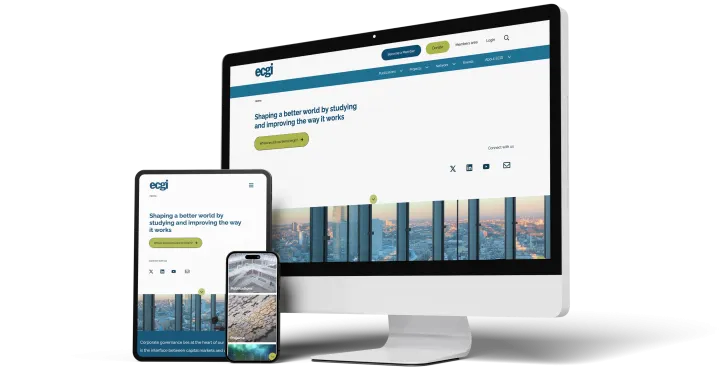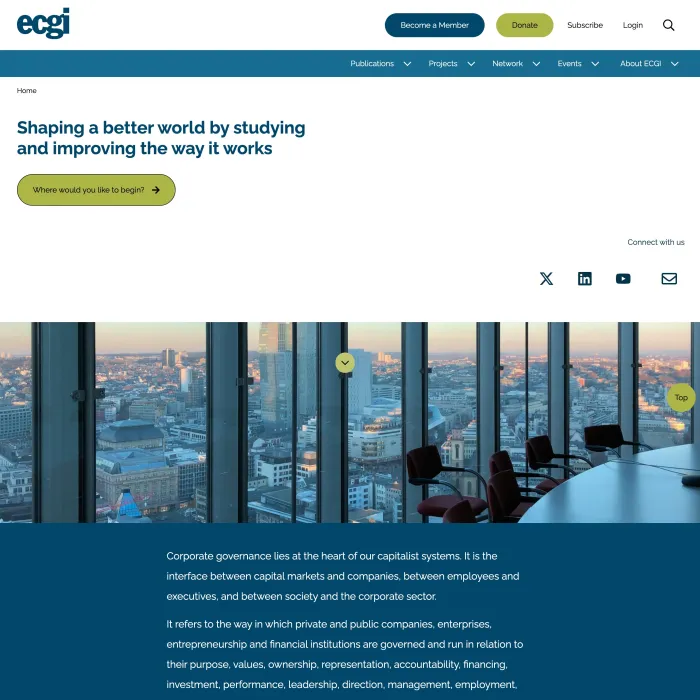ECGI’s complicated Drupal 7 migration pays off with brilliant content and functionality

Drupal Development
Stakeholder workshops
Information architecture
The European Corporate Governance Institute’s Drupal 7 website was replaced with an elegant, efficient Drupal 10 site. Intricate tagging and search capabilities ensure the new website is easy to manage and it is simple to interlink large amounts of content.
Project background
The European Corporate Governance Institute (ECGI) was established to improve corporate governance through fostering independent scientific research and related activities.
Its previous website was launched in 2017. At the time it transformed ECGI’s operations and ability to publish content faster and share news about its research members’ events and activities around the world. But since then ECGI’s research scope, network and publicly available resources expanded significantly.
By 2024 it had more than 8,500 subscribers and 4,000 monthly website users, and it was time to improve how ECGI provided access to its vast resources.

The new ECGI website is slick and fast, and presents a lot of content in a way that doesn't overwhelm the user.
About the website
Much of the content ECGI publishes is on corporate governance, as well as information on events relating to corporate governance.
There are currently about 1,000 active members, who vary from academics to corporate members to those involved in the corporate governance world in various sectors, including law and finance.
The website has many purposes:
- It is a publishing powerhouse - it hosts many different content types for academic papers, corporate governance and stewardship codes, videos, blog posts, and reports.
- It acts as a platform to present information on important projects that ECGI is undertaking.
- It is a networking hub for the corporate governance community. Its events bring together people from corporate governance world.
By 2024 the old website was outdated and was running on Drupal 7, which reaches end of life in January 2025.
The crucial challenge was that the old website contained all of the functionality needed to allow ECGI to publish a vast amount of information to its thousands of users. All of this functionality would have to be rebuilt as part of the new site, so understanding and replicating this functionality was key to the project's success.
ECGI is a valuable public resource which could either be a treasure trove or an abyss of research-based content, depending on the quality of our website. Thanks to Annertech, the vast amount of content is easy to navigate and the website is flexible and responsive, as are the project and maintenance teams that we have had the pleasure of working with.
– Elaine McPartlan, General Manager of ECGI
Challenges
A project of this scale inherently comes with several challenges, as you might expect. Some of the primary challenges of this project included:
1. Replication of existing functionality
ECGI’s existing website had been created several years before, and then was fine-tuned over years to carry out specific publishing processes, as well as specific member management tasks.
With ECGI’s rapid member growth, these processes become even more important to carry forward. The team had spent years building up a number of custom features in Drupal 7 that would need to be rebuilt from scratch. Plus, many features had been tacked on over the years.
2. There was a lot that needed to be carried over
The ECGI website was very heavy content-wise. More than 40,000 digital items needed to be migrated from the legacy website. This included 6,000 pages, 16,000 media items, and 3,800 people.
In addition to the structured content, the information architecture required revision to reign in legacy content and improve the user experience. There were uncategorised pages and links to pages that didn’t exist. It was a large website, with lots of content and no pruning done over the years so it had grown organically into a monster.
3. A complicated registration process
Growing membership is key to ECGI's business model. This presented a challenge because the existing version of the ECGI website routed users through a payment system to complete the registration process.
Originally, this flow was implemented with the intention of having users pay for registration when registering, but was later changed, leaving the process feeling disjointed. As a result, this process had the potential to cause confusion for prospective members.
4. Technical aspects around the migration
The biggest technical aspects of the project were centred on the migration.
There were lots of content types that needed to be migrated. Within those content types, there were numerous fields that hadn't been standardised.
To make it more complicated the member section contained profile pages with thousands of links to other types of information, such as working papers or blog posts they had written, and videos or news articles about them.
Our approach
Technical documentation
The first step was a large discovery stage, which was heavily focused on technical documentation of the site.
One thing that differentiates ECGI from other websites is the extensive use of tagging and contextual views. There is also a huge number of listings that rely on this tagging functionality. But once the tagging system was in place, it allowed for information to be pulled in automatically, where it was needed.
Not only does the process work seamlessly, it also ensures that the information that is displayed is fresh and relevant, and reduces editor overheads.
Design
The design was approached differently out of necessity. Wireframes of the entire site were created to plot specific functionality requirements.

Although this resulted in an extensive number of wireframes, more than is typically required, it made it easier to focus on what functionality is needed before getting tied up on more visual aspects.
This was absolutely vital as there was so much functionality that needed to be mapped, and from a technical perspective it was the most important exercise.
We also developed a detailed UX design demonstrating all functionalities to be included.
The structure of the homepage was designed to ease the user into the wealth of resources available by establishing the core values and international impact of the ECGI:

Pathways to the large amount of content and resources made available on the site are broken into sections — “Publications”, “Projects”, “Network” and “Events” — with links to appropriate content at secondary and tertiary levels. And way-finding blocks help the user navigate to other sections:

In approaching the user interface, we wanted to respect the established branding of the ECGI, but to also use some of the brand’s elements and colours to create bold and eye-catching components. The goal of the UI design was to extend the robust elements of the ECGI brand to the website while remaining unobtrusive to access to information.
A form-follows-function approach was taken to ensure a minimal aesthetic, and instead rich imagery and impactful typography were used to convey the character of the organisation.
As a public facing resource accessibility was paramount. Accessibility compliance checks were carried out on colours, typography, and focus states, and user-centred design methods were used as a guide throughout the design phase.
Solutions to the challenges
This is how we addressed the primary challenges of this project:
1. Functionality
A large discovery process ensured that
- the functionality of the new website would be aligned with the technical functionality of the old website, and
- the project's requirements were successfully detangled, especially when it came to the code and configuration.
2. Content migration
From a content viewpoint, lots of trimming was needed. There were sections that didn’t need to be there, and islands of content that had no parents and that didn’t live anywhere.
To address this, we took a ground-up approach to content, and undertook a series of workshops to discover exactly what content and structure would work best for the ECGI users.
3. Registration process
The registration process was a barrier to membership. To ensure that this wasn’t an issue, we streamlined the process with an easy-to-use online registration form and a simplified payment process.
4. Migration technicalities
Within the large number of content types that needed to be migrated, fields such as media etc needed to be standardised with growth and scalability in mind to carry the website forward into the future.
This was particularly important around users/members. Each ECGI member has a public profile page that links to many other types of information – working papers, blog posts, videos or news articles:
We used a contextual filters to pull in these different information types by using an extensive tagging system. This ensures that the member content is always relevant and up to date.

Results
ECGI.global is a high-performing, fast and efficient website. It is easy to navigate and find what you're looking for, despite it being a very large repository that contains a wealth of information – over 40,000 digital items were migrated from the old ECGI website.
The website has many types of inter-connected mixed-media content and different user categories depending on appointments and membership designations. But thanks to its extensive tagging and filtering capabilities much of the linking happens automatically, reducing the burden on editors.
Due to the website's excellent search capability, tagging system and new structure, content is easy to find.
Plus the new website performs brilliantly. Google’s Lighthouse tool combines different performance metrics and gives websites a score rating from 0 to 100. ECGI.global's Lighthouse Performance Score has increased from 63% to 99%.
And it's a lot faster now. The new website loads fully in 1 second, compared with the old website's fully loaded time of 2.3 seconds.



